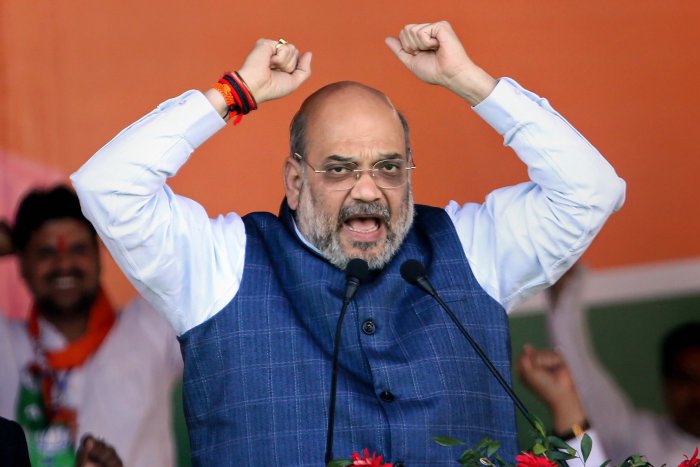
Amit Shah is loud and clear: BJP will hold on to its Hindutva plank
“Mamata Banerjee is opposing a law passed by Parliament. But, nothing can stop us from embracing our immigrant brothers. Tell Mamata didi she is ruining the legacy of Rabindranath Thakur, Mahatma Gandhi...” For those of you who missed his goli-maaro rally in Kolkata, this is the gist of Hindutva-icon Amit Shah’s speech at Kolkata on Sunday.

“Mamata Banerjee is opposing a law passed by Parliament. But, nothing can stop us from embracing our immigrant brothers. Tell Mamata didi she is ruining the legacy of Rabindranath Thakur, Mahatma Gandhi…” For those of you who missed his goli-maaro rally in Kolkata, this is the gist of Hindutva-icon Amit Shah’s speech at Kolkata on Sunday (March 1).
Shah’s version of history is generally taken as gospel by members of WhatsApp groups loyal to the Hindutva project. But, for those who have had the great fortune of being educated properly on India’s history and culture, Shah’s speech would have been both comic and ironic — which is usually the case every time the redoubtable home minister speaks these days.
Shah invoked Gandhi’s name in the very place where the Mahatma, armed with the force of his will, moral authority and the courage to put his own life at stake, had quelled post-Partition riots. Shah, in contrast, had just descended on Kolkata from Delhi where the biggest Hindu-Muslim riots since Partition had unfolded under the watch of his home ministry.
Consider the tragic irony. In 1947, as Muslims and Hindus threatened to butcher each other on the streets of Kolkata, Gandhi began a fast unto death till the rioting had stopped completely. In contrast, Shah could not bring Delhi under control for almost three days, in spite of having the Delhi police and central security forces under his baton, leading to the murder of at least 46 persons.
Related news | BJP will come to power next in West Bengal, says Amit Shah
In any other country — except in a dictatorship, or a dictatorship masquerading as a democracy — Shah would have by now been held accountable for the clashes that turned into a pogrom directed at Muslims and their properties under the benign gaze of the Delhi police. But, Shah instead had the temerity and the chutzpah to not only occupy the bully pulpit in Kolkata but also preach communalism in the name of India’s greatest secular icons.
The message is clear. As national security advisor Ajit Kumar Doval said in Delhi while touring the riot-affected areas — jo hua so hua (whatever happened is history, now move on). So, without a crease on his brow, a stain on his conscience or an adverse remark on his CV, Shah has moved on, to implement his Hindutva project in West Bengal.
Shah’s rally, his speech and the slogans raised in Kolkata by his supporters are clear indications that the BJP will now go the full Monty on Hindutva. Unlike in Haryana, Jharkhand and Delhi, where Hindutva was unleashed either half-heartedly or in the final stage of the campaign, polarisation would be the BJP’s main weapon in West Bengal.
It will keep the Hindutva pot boiling in Bengal through its trademark strategy of raising the bogey of injustice (against the Hindus), calling Mamata Banerjee a messiah of Muslims (and, thus, an enemy of the nation) and making provocative remarks that would keep the state perennially on the edge.
Related news | Bengal BJP evaluating leaders’ performance, set for major overhaul
Many would find the BJP’s strategy perplexing, especially after the outcome of the Delhi assembly polls. The perception within the opposition and a section of analysts was that the BJP will step back from the politics of polarisation after the Delhi rout. But, those who entertain this notion do not understand the psychology and psephology of the BJP.
For Shah and the BJP’s think-tank, the increased vote-share in Delhi — from 32 to around 40 per cent — would have been a vindication of its politics of polarisation. After the results, Shah would have told himself that the BJP would have slid below the 30 per cent mark if he had not led a campaign to consolidate its core base by turning the election into a referendum on the citizenship amendment act and a veritable war against those opposing it. He would have noticed that faced with the Hindutva onslaught, even Arvind Kejriwal, whose government enjoyed high popularity ratings, was forced to embrace soft-Hindutva and invoke the name of deities.
In contrast, Banerjee is a more vulnerable target. For she neither has a record that matches Kejriwal’s on delivery nor is she in a position to embrace soft-Hindutva because of her strident opposition to issues embraced by the saffron brigade. Banerjee’s only option would be to counter BJP’s Hindutva with her version of Bengali pride. But, the BJP’s gains in the 2019 general elections—its vote share rose by 22 per cent—show its Hindutva card has a lot more purchasing power in Bengal than Banerjee’s regionalism.
The BJP has nothing to show on the governance front. Its record on generating jobs is pathetic—a factor that made 3 in 5 voters in the 18-25 age group vote for the AAP. Under its watch, the economy has hurtled from one disaster to another and its growth rate today is the lowest in eight years. Apart from some slogans that are a mix of propaganda and canards, the BJP doesn’t have much to offer.
But, in spite of its failures, the BJP has succeeded in turning hate into a perennial poll agenda. By mainstreaming, legitimising and rewarding it, the party has unleashed the bottled bigotry of a large section of Indians into electoral politics. It is, as Arundhati Roy argues, India’s very own coronavirus for which the ailing bigots are currently expressing gratitude to the purveyors and super-spreaders.

